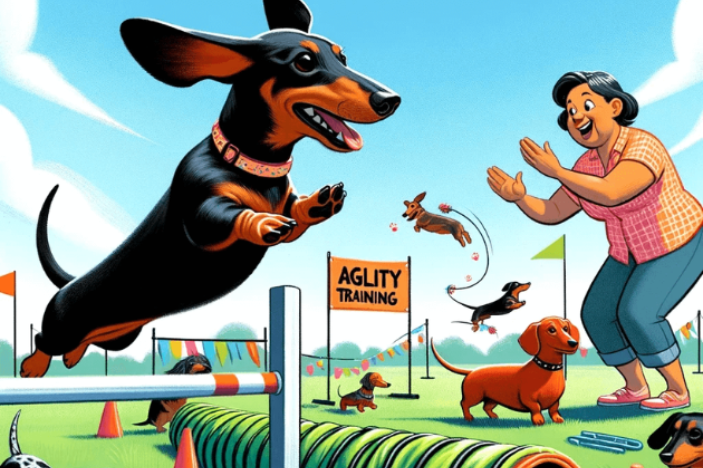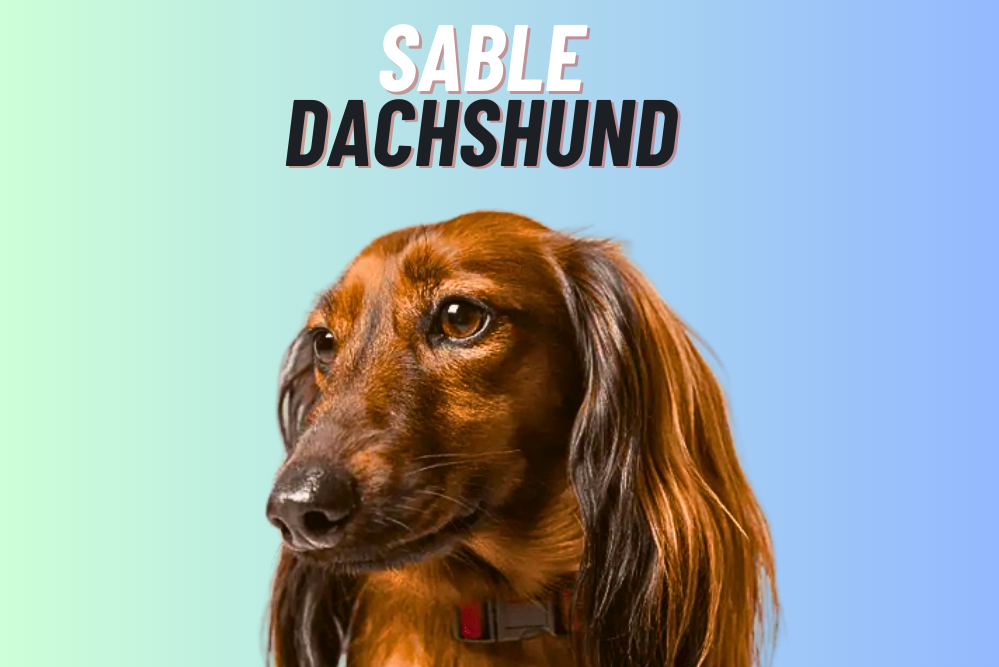Aggressive dachshund training
Training an aggressive dachshund can be a challenging task, but it is important to address this behavior as soon as possible for the safety of both the dog and others around them. Here are some tips on how to train an aggressive dachshund:
- Identify the Trigger: The first step in training an aggressive dachshund is to identify the trigger that sets them off. It could be anything from being touched while eating to encountering strangers. Once you know the trigger, you can work on desensitizing your dachshund to that trigger.
- Consistency: Consistency is key when training any dog, but especially an aggressive one. Make sure everyone in the household is using the same commands and techniques when working with the dachshund. This will prevent confusion and make the training process smoother.
- Positive Reinforcement: Reward-based training is one of the most effective ways to train an aggressive dachshund. Instead of punishing your dog for bad behavior, reward them for good behavior. This will help them associate positive outcomes with good behavior and reinforce good habits.
- Socialization: Socialization is crucial for any dog, but it is especially important for aggressive dachshunds. Expose them to different people, animals, and environments so that they become comfortable in different situations. This will help reduce their aggressive tendencies.
- Seek Professional Help: If your dachshund’s aggression is severe or you are unable to train them on your own, seek the help of a professional dog trainer. They can assess the situation and provide customized training for your dachshund’s specific needs.
It is important to remember that training an aggressive dachshund takes time and patience. Don’t expect immediate results, and don’t give up if you don’t see progress right away.
With consistency, positive reinforcement, and socialization, you can help your dachshund overcome their aggressive tendencies and become a well-behaved, happy pet
Why is my Dachshund being aggressive?
There are many reasons why a dachshund may be displaying aggressive behavior. It is important to identify the root cause of the aggression in order to properly address it. Here are some possible reasons why your dachshund may be aggressive:
- Fear: Aggression can be a natural response to fear or anxiety. If your dachshund feels threatened or scared, it may display aggressive behavior as a way to protect itself.
- Lack of Socialization: Dachshunds that have not been properly socialized may be more prone to aggressive behavior. If they are not exposed to a variety of people, animals, and environments, they may become fearful or aggressive when faced with new situations.
- Dominance: Some dachshunds may display aggressive behavior as a way to assert their dominance. This can be especially true in households where the dog is not properly trained and may feel like they are in charge.
- Pain or Discomfort: If your dachshund is experiencing pain or discomfort, it may display aggressive behavior as a way to protect itself. It is important to take them to the vet to rule out any underlying medical issues.
- Previous Trauma: Dachshunds that have experienced trauma, abuse, or neglect in their past may be more prone to aggressive behavior. In these cases, it may take extra time and patience to address the behavior and help them feel safe and secure.
It is important to work with a professional dog trainer or behaviorist to properly assess the cause of your dachshund’s aggression and develop a training plan to address it. With proper training and patience, you can help your dachshund overcome their aggressive tendencies and become a well-behaved, happy pet
How to tire out a dachshund?
Dachshunds are energetic dogs that require regular exercise to maintain their physical and mental health. Here are some ways to tire out a dachshund:
- Go for Walks: Regular walks are an essential part of a dachshund’s exercise routine. Aim for at least two walks per day, and consider adding in some extra walks or increasing the length of the walks if your dachshund still has the energy to burn.
- Play Fetch: Many dachshunds love to play fetch. Find a safe, open area and throw a ball or toy for your dachshund to chase after. This can help burn off energy and provide mental stimulation.
- Use Puzzle Toys: Puzzle toys, such as treat-dispensing balls or toys that require your dachshund to figure out how to get to the treat inside, can provide mental stimulation and tire out your dachshund.
- Take a Hike: If you have access to hiking trails or other outdoor areas, take your dachshund on a hike. This can provide a more challenging workout and give your dachshund a chance to explore new environments.
- Go Swimming: Some dachshunds enjoy swimming, and it can be a great way to tire them out. Find a safe area to swim, such as a pool or lake, and supervise your dachshund at all times.
- Consider Agility Training: Agility training can be a fun and challenging way to tire out your dachshund. Look for local agility classes or set up your own agility course in your backyard.
It is important to tailor your dachshund’s exercise routine to their individual needs and abilities. Start with shorter walks or play sessions and gradually increase the intensity and duration as your dachshund becomes fitter. Always supervise your dachshund during exercise and make sure they have access to plenty of water
How would you quiet down an aggressive dachshund?
If your dachshund is displaying aggressive behavior, it is important to address the root cause of the aggression and work with a professional dog trainer or behaviorist to develop a training plan.
Here are some general tips to help calm down an aggressive dachshund:
- Stay Calm: If your dachshund is displaying aggressive behavior, it is important to remain calm and avoid reacting with anger or frustration. This can escalate the situation and make it worse.
- Remove the Trigger: If you can identify the trigger for your dachshund’s aggression, such as a particular person or object, remove it from the situation if possible.
- Provide a Safe Space: If your dachshund is feeling anxious or threatened, provide them with a safe space where they can retreat and feel secure, such as a crate or designated area in your home.
- Use Positive Reinforcement: Positive reinforcement, such as treats or praise, can be a powerful tool in training an aggressive dachshund. Reward good behavior and redirect negative behavior with positive reinforcement.
- Teach Basic Commands: Teaching basic obedience commands, such as “sit” or “stay,” can help establish you as the pack leader and give your dachshund a sense of structure and security.
- Avoid Punishment: Avoid using physical punishment or yelling at your dachshund if they display aggressive behavior. This can reinforce the behavior and make it worse.
It is important to work with a professional dog trainer or behaviorist to address any aggressive behavior in your dachshund. With patience, consistency, and positive reinforcement, you can help your dachshund overcome their aggressive tendencies and become a well-behaved, happy pet
Can a dachshund become hostile to you at any time?
Any dog, including a dachshund, has the potential to become hostile towards a person or other animals, especially if they feel threatened, fearful, or protective.
However, it is important to note that aggression in dogs is not a normal or acceptable behavior, and can often be prevented or managed through proper training, socialization, and care.
Aggression in dachshunds can be caused by various factors, including genetics, lack of socialization, fear, anxiety, medical issues, and previous negative experiences.
It is important to monitor your dachshund’s behavior and look for signs of aggression, such as growling, biting, snapping, or showing teeth, and address any issues promptly with the help of a professional dog trainer or behaviorist.
By providing your dachshund with proper training, exercise, socialization, and care, you can reduce the risk of aggression and promote a happy, healthy relationship between you and your pet.
It is also important to remember that each dog is an individual and may have their own unique personality and tendencies, so it is important to always be aware and respectful of your dachshund’s needs and behaviors
Is it possible to get rid of a dachshund by force at any time?
No, it is not appropriate or legal to get rid of a dachshund, or any pet, by force at any time. Dogs, including dachshunds, are living creatures and depend on their owners for love, care, and protection. Abandoning or mistreating a dachshund is not only cruel, but it is also illegal in most countries.
If you are no longer able to care for your dachshund or are considering giving them up, there are humane and responsible ways to do so. You can contact a local animal shelter or rescue organization to surrender your dachshund or consider finding a new home for them through a reputable adoption or rehoming service.
It is important to remember that owning a dachshund, or any pet, is a long-term commitment and requires time, effort, and resources to provide for their physical and emotional well-being. Before bringing a dachshund into your home, make sure you are prepared to meet their needs for exercise, socialization, training, and healthcare for their entire lifetime.
How do you train a stubborn Dachshund?
Dachshunds are known to be stubborn, which can make training a challenge. However, with patience, consistency, and positive reinforcement, you can successfully train your dachshund. Here are some tips for training a stubborn dachshund:
- Be Patient: Dachshunds are intelligent but independent dogs, and they may take longer to learn new commands. It is important to be patient and avoid getting frustrated or angry if your dachshund is not responding as quickly as you would like.
- Use Positive Reinforcement: Positive reinforcement, such as treats or praise, can be a powerful motivator for dachshunds. Reward good behavior and ignore or redirect negative behavior, rather than using punishment or negative reinforcement.
- Keep Training Sessions Short: Dachshunds have short attention spans and can become easily bored or distracted. Keep training sessions short and focused, and gradually increase the length and complexity of the training as your dachshund progresses.
- Make Training Fun: Dachshunds respond well to training that is fun and engaging. Use toys or games to make training more enjoyable for your dachshund, and incorporate playtime into your training sessions.
- Socialize Your Dachshund: Socialization is important for all dogs, but especially for dachshunds, who can be prone to anxiety and fearfulness. Expose your dachshund to new people, animals, and environments in a positive and controlled way to help them become more confident and well-adjusted.
- Seek Professional Help: If you are having difficulty training your dachshund, consider working with a professional dog trainer or behaviorist. They can help you develop a training plan that is tailored to your dachshund’s individual needs and abilities.
Remember that training a stubborn dachshund requires patience, consistency, and a positive attitude. By using positive reinforcement, keeping training sessions fun and engaging, and seeking professional help when needed, you can successfully train your dachshund and enjoy a happy, well-behaved pet
Should I hit my Dachshund?
No, hitting a dachshund or any other dog is not an acceptable or effective way to train or discipline them. Physical punishment can cause fear, anxiety, and aggression in dogs, and can damage the bond of trust between you and your pet.
Positive reinforcement, on the other hand, is a more effective and humane way to train your dachshund. This involves rewarding good behavior with treats, praise, and affection, and redirecting negative behavior with positive reinforcement techniques such as ignoring the behavior or giving your dachshund a command that they know and respond to.
If you are having trouble with your dachshund’s behavior, seek the help of a professional dog trainer or behaviorist who can work with you to develop a positive training plan that is tailored to your dachshund’s needs and personality. With patience, consistency, and positive reinforcement, you can train your dachshund to be a well-behaved and happy companion.
Conclusion
In conclusion, training an aggressive dachshund requires patience, consistency, and a deep understanding of the dog’s behavior. Aggression in dogs can be caused by various factors, including fear, territorialism, and dominance.
It’s essential to identify the root cause of aggression and develop a personalized training plan accordingly. Positive reinforcement techniques, such as rewarding good behavior, can help redirect the dog’s behavior and build trust between the owner and the dog.
It’s important to remember that training an aggressive dachshund can be a long and challenging process, but with dedication and the right approach, it’s possible to overcome the aggression and build a happy and healthy relationship with your furry friend.
Always consult with a professional dog trainer or behaviorist for guidance and support during the training process.




